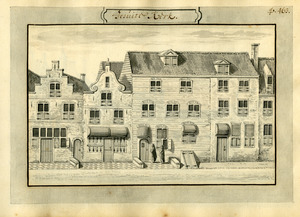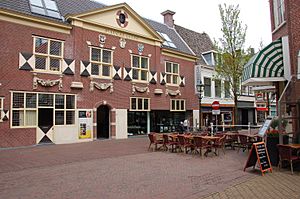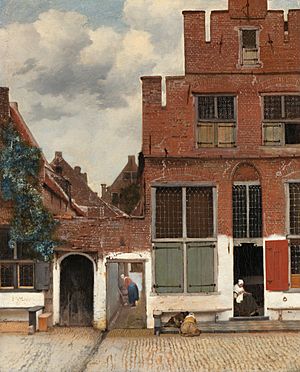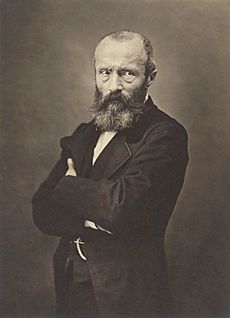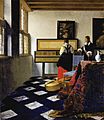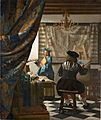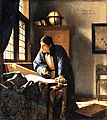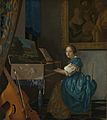Johannes Vermeer facts for kids
Quick facts for kids
Johannes Vermeer
|
|
|---|---|
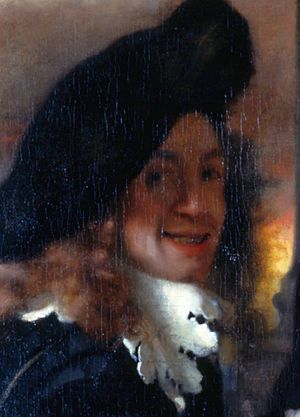
Detail of the painting The Procuress (c. 1656), believed to be a self portrait by Vermeer
|
|
| Born |
Joannis Vermeer
baptised 31 October 1632 |
| Died | 15 December 1675 (aged 43) Delft, Holland, Dutch Republic
|
| Known for | Painting |
|
Notable work
|
34 works universally attributed |
| Movement | Dutch Golden Age Baroque |
| Spouse(s) | Catharina Bolnes |
| Signature | |
 |
|
Johannes Vermeer (also known as Jan Vermeer; October 1632 – 15 December 1675) was a famous Dutch painter. He lived during the Dutch Golden Age, a time when Dutch art was very popular. Vermeer is known for his beautiful paintings of everyday life inside homes. He often showed scenes of middle-class people.
Vermeer is considered one of the greatest painters of his time, alongside Rembrandt. During his life, he was a successful painter in his hometown of Delft and in The Hague. He didn't paint many pictures, and he also worked as an art dealer to make a living. When he died, he wasn't rich, and his family was left with debts.
Vermeer painted slowly and carefully. He used very expensive pigments (colors) in his art. He is especially famous for how he used light in his paintings. It made his artwork look very real and glowing. Many of his paintings show the same rooms in his house in Delft. They also often show the same people, usually women.
After he died, Vermeer's fame faded away. People hardly mentioned him for almost 200 years. Then, in the 1800s, art experts rediscovered his work. Since then, Vermeer's reputation has grown a lot. Today, he is one of the most admired painters in history.
Contents
Life of Johannes Vermeer
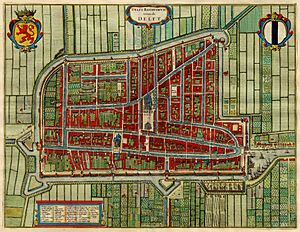
Not much was known about Vermeer's life until recently. He spent his whole life in Delft, focusing on his art. For a long time, the only information came from official records and comments from other artists. This led some to call him "The Sphinx of Delft" because he was so mysterious. Later, a historian named John Michael Montias found more details about Vermeer's family in old city records.
Vermeer's Early Life and Family
Johannes Vermeer was baptized on October 31, 1632. His mother, Digna Baltens, was from Antwerp. His father, Reijnier Janszoon, worked with silk. Reijnier also started buying and selling paintings. In 1631, he rented an inn called "The Flying Fox." Later, he bought a bigger inn called "Mechelen" in 1641. This was a big financial challenge for him. When Reijnier died in 1652, Vermeer took over the family art business.
Marriage and Family Life
In April 1653, Johannes Vermeer married Catharina Bolnes. She was from a Catholic family. Catharina's mother, Maria Thins, was much wealthier than Vermeer. She didn't want them to marry at first. It's believed she asked Vermeer to become Catholic before the wedding. A Catholic painter named Leonaert Bramer spoke up for Vermeer, and Maria Thins finally agreed.
Vermeer seemed to truly believe in Catholicism. One of his paintings, The Allegory of Faith, shows religious symbols. It might have been made for a special Catholic patron or even a "hidden church." After they married, Vermeer and Catharina moved in with Catharina's mother. They lived in a large house near a hidden Jesuit church. Vermeer painted in a front room on the second floor of this house.
Vermeer and Catharina had 15 children, but four died young. We know the names of 10 of their children. Many of their names had religious meanings. Their youngest son, Ignatius, was likely named after the founder of the Jesuit order.
Vermeer's Painting Career
It's not clear who taught Vermeer how to paint. Some people think Carel Fabritius might have been his teacher, but there's no strong proof. Leonaert Bramer was a friend, but their painting styles were very different. Some experts believe Vermeer taught himself, perhaps using connections from his father's art business.
On December 29, 1653, Vermeer joined the Guild of Saint Luke. This was a special group for painters. Vermeer didn't pay the usual fee to join. This was a difficult time because of the plague, war, and money problems. In 1654, a huge explosion, called the Delft Thunderclap, destroyed a big part of Delft.
Pieter van Ruijven and Maria de Knuijt were important supporters of Vermeer. Maria de Knuijt was identified as his main patron. This means she bought many of his paintings and supported him for a long time. Vermeer's paintings were expensive. He probably sold most of them to a few special collectors.
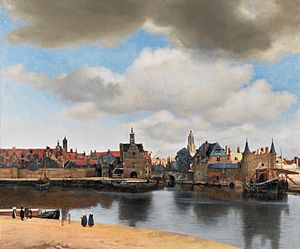
Vermeer's style influenced other painters like Gabriel Metsu. In 1662, Vermeer was chosen to lead the Guild of Saint Luke. He was re-elected several times, showing that other artists respected him. Vermeer painted slowly, perhaps only three paintings a year. In 1663, a visitor named Balthasar de Monconys wanted to see Vermeer's work. But Vermeer had no paintings to show. The visitor had to go to a baker, Hendrick van Buyten, who had some of Vermeer's paintings as payment for a debt.
Wars and Vermeer's Death
In 1672, the Netherlands faced a very hard time, known as the "Year of Disaster." Louis XIV of France invaded the country. An English fleet attacked by sea, and German bishops invaded from the east. This caused a lot of damage and fear. Many places, like courts and shops, closed down. Vermeer sold his last painting that year.
Vermeer died on December 15, 1675, at age 43, after a short illness. He was buried in the Old Church in Delft. His wife, Catharina Bolnes, told her creditors that her husband's death was caused by money worries. She said he couldn't sell his art during the war. He also had other paintings he was trying to sell as an art dealer. This stress, along with having many children to support, made him very sick.
After Vermeer's death, Antonie van Leeuwenhoek, a famous scientist who invented the microscope, helped manage Vermeer's belongings. An inventory of Vermeer's house showed his studio had easels, palettes, and canvases. Nineteen of Vermeer's paintings went to his wife and mother-in-law. His wife had to sell two more paintings to pay off debts.
Vermeer was respected in Delft, but he was not well-known outside his city. A local supporter, Pieter van Ruijven, bought many of his paintings. This helped Vermeer financially but also meant his art didn't spread far. Vermeer never had students. Some think he might have taught his oldest daughter, Maria, to paint. His large family and his work as an art dealer and inn-keeper also took up a lot of his time. His careful painting style also meant he produced fewer works.
Vermeer's Painting Style
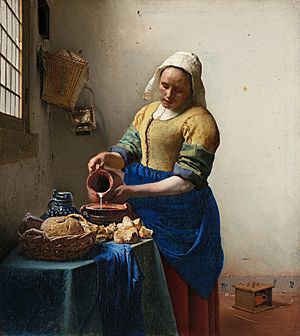
Vermeer likely started his paintings with simple shades of gray or brown. Then he added bright colors like reds, yellows, and blues in thin layers. We don't have any drawings by Vermeer, so we don't know much about how he planned his paintings.
Vermeer was one of the first artists to use a very expensive blue color called ultramarine. This color came from a rare stone called lapis lazuli. He used it a lot, even in the early layers of his paintings, under other colors. This made the final colors look richer and cooler. He might have learned this from Leonardo da Vinci's ideas about how objects reflect colors from nearby things.
For example, in The Girl with the Wine Glass, Vermeer used ultramarine under the red dress. This made the red look slightly purple and very crisp. Even when he had money problems after the "Year of Disaster" in 1672, he still used this expensive blue. This might mean that a patron, like Pieter van Ruijven, supplied him with painting materials.
Most of Vermeer's works are scenes of everyday life or portraits. He also painted two city views and two allegories (paintings with symbolic meanings). His subjects show different parts of Dutch society in the 1600s. He painted everything from a simple milkmaid to wealthy merchants in their grand homes. His art also included religious, poetic, musical, and scientific ideas.
Vermeer's Painting Materials
Vermeer was very careful about the colors he chose. He is famous for using expensive ultramarine (in The Milkmaid). He also used lead-tin-yellow (in A Lady Writing a Letter), madder lake (in Christ in the House of Martha and Mary), and vermilion. Other colors he used included ochres, bone black, and azurite. Experts have found about 20 different colors in his paintings. The main ones were lead white, yellow ochre, vermilion, madder lake, green earth, raw umber, and ivory or bone black.
Theories About Mechanical Aids in Painting
Vermeer's painting techniques have been debated for a long time. His paintings look almost like photographs, with amazing detail. But he didn't have formal training, and there's little proof he made sketches.
In 2001, artist David Hockney suggested that Vermeer used optical tools, like curved mirrors or a camera obscura. A camera obscura is like a dark box with a small hole or lens. It projects an image onto a surface. This idea is called the Hockney–Falco thesis.
Another expert, Philip Steadman, also suggested Vermeer used a camera obscura. He noticed that many of Vermeer's paintings were made in the same room. He found that six of his paintings were the right size to have been traced from a camera obscura image.
People who support these ideas point to the sparkling highlights in Vermeer's paintings. They think these might be caused by the simple lenses of a camera obscura. They also suggest that the "exaggerated" perspective in The Music Lesson could be from using such a device.
In 2008, an inventor named Tim Jenison developed his own theory. He thought Vermeer used a camera obscura with a "comparator mirror." This mirror would help match colors. Jenison spent five years trying to recreate The Music Lesson using these tools. This process was shown in the movie Tim's Vermeer.
Jenison pointed out that Vermeer painted light falling on walls very accurately. He also noted that some details in Vermeer's paintings, like the curved scrollwork on a musical instrument in The Music Lesson, matched what Jenison saw using his mirror setup.
However, this theory is still debated. There's no historical proof that Vermeer was interested in optics. The list of his belongings after he died doesn't include any camera obscura. But Vermeer was friends with Antonie van Leeuwenhoek, who was a pioneer in making lenses.
Vermeer's Works
It's believed Vermeer painted fewer than 50 pictures in total. Only 34 of them still exist today. Only three of his paintings have dates on them: The Procuress (1656), The Astronomer (1668), and The Geographer (1669).
Vermeer's mother-in-law owned a painting called The Procuress by Dirck van Baburen. This painting appears in the background of two of Vermeer's own works. Vermeer also painted his own version of The Procuress. Most of Vermeer's paintings show everyday scenes. They are usually smaller in size and use cool colors like blues, yellows, and grays.
Almost all of his surviving works are from this period. They often show indoor scenes with one or two people, lit by a window on the left. These paintings are known for their balanced look and sense of space. A soft, glowing light brings everything together. Simple daily activities, like a girl reading a letter, feel timeless and poetic. Vermeer also painted two city scenes: View of Delft and The Little Street.
A few of his later paintings look a bit different, with a harder style. These include The Allegory of Faith (around 1670) and The Love Letter (around 1670).
Vermeer's Legacy
For about 200 years after his death, art historians mostly forgot about Vermeer's work. Only a few art lovers in the Netherlands knew about him. Many of his paintings were even thought to be by other artists like Gabriel Metsu or Mieris.
Vermeer's modern rediscovery began around 1860. A German museum director named Gustav Waagen saw The Art of Painting and realized it was a Vermeer. At the time, it was thought to be by Pieter de Hooch. Later, Théophile Thoré-Bürger did a lot of research on Vermeer. In 1866, he published a list of Vermeer's works. This made Vermeer famous around the world.
After Vermeer's work was rediscovered, many artists were inspired by him. These included Dutch painter Simon Duiker, Danish painter Wilhelm Hammershoi, and American artist Thomas Wilmer Dewing. In the 1900s, even Salvador Dalí, a famous surrealist artist, admired Vermeer. Dalí painted his own version of The Lacemaker and created a painting called The Ghost of Vermeer of Delft Which Can Be Used As a Table.
Images for kids
-
Girl with the Red Hat (c. 1665-1666), National Gallery of Art
-
The Art of Painting or The Allegory of Painting (c. 1666–1668), Kunsthistorisches Museum in Vienna
-
The Astronomer (c. 1668), Musée du Louvre in Paris
-
Lady Writing a Letter with her Maid (c. 1670–71), National Gallery of Ireland in Dublin, Ireland
-
The Allegory of Faith (1670 - 1672), Metropolitan Museum of Art in New York
-
Lady Seated at a Virginal (c. 1670–72), National Gallery in London
See also
 In Spanish: Johannes Vermeer para niños
In Spanish: Johannes Vermeer para niños


